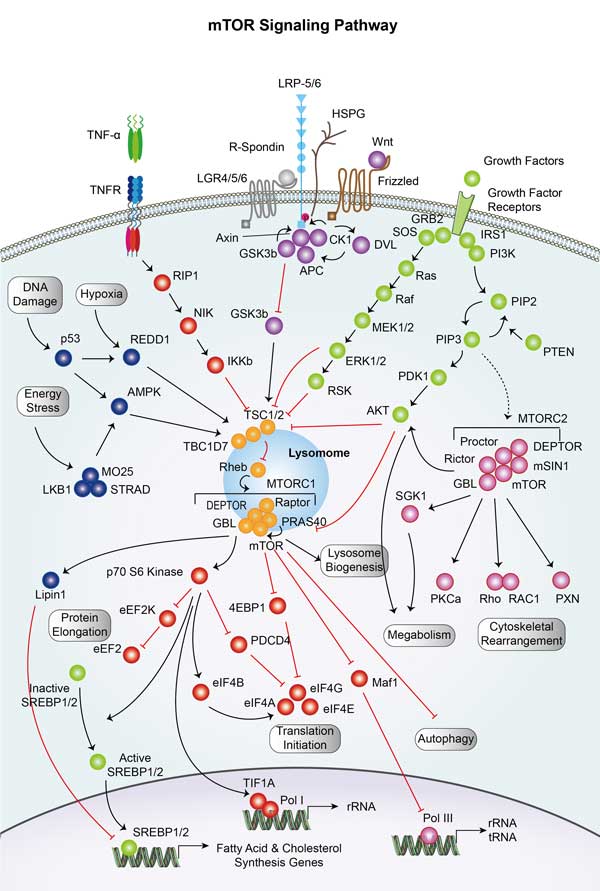RPTOR
-
Official Full Name
regulatory associated protein of MTOR, complex 1 -
Overview
This gene encodes a component of a signaling pathway that regulates cell growth in response to nutrient and insulin levels. The encoded protein forms a stoichiometric complex with the mTOR kinase, and also associates with eukaryotic initiation factor 4E-binding protein-1 and ribosomal protein S6 kinase. The protein positively regulates the downstream effector ribosomal protein S6 kinase, and negatively regulates the mTOR kinase. Multiple transcript variants encoding different isoforms have been found for this gene. -
Synonyms
KOG1;Mip1;KIAA1303;regulatory-associated protein of mTOR;raptor;p150 target of rapamycin (TOR)-scaffold protein containing WD-repeats;RPTOR;regulatory associated protein of MTOR, complex 1
| Cat.# | Product name | Source (Host) | Species | Tag | Protein Length | Price |
|---|---|---|---|---|---|---|
| RPTOR-30506TH | Recombinant Human RPTOR | Wheat Germ | Human | Non | 379 amino acids |
|
| RPTOR-1543HCL | Recombinant Human RPTOR cell lysate | Human | Non |
|
||
| RPTOR-2666H | Recombinant Human RPTOR Protein, His-tagged | E.coli | Human | His | Asn1020-Arg1335 |
|
| RPTOR-448HF | Recombinant Full Length Human RPTOR Protein | In Vitro Cell Free System | Human | Full L. 379 amino acids |
|
Involved Pathway
RPTOR involved in several pathways and played different roles in them. We selected most pathways RPTOR participated on our site, such as mTOR signaling pathway,PIK-Akt signaling pathway,AMPK signaling pathway, which may be useful for your reference. Also, other proteins which involved in the same pathway with RPTOR were listed below. Creative BioMart supplied nearly all the proteins listed, you can search them on our site.
| Pathway Name | Pathway Related Protein |
|---|---|
| PIK-Akt signaling pathway | IFNA5,FGF8,GNG10,MET,MCL1,IL2RA,AKT2,THBS1,IL6,HSP90AA1 |
| mTOR signaling pathway | PDPK1,RPS6KB1B,PIK3R3A,PTEN,ULK1,TSC1A,PIK3R3,PIK3CB,MTOR,INS2 |
| Insulin signaling pathway | HRAS,PRKAR2A,PHKG2,BRAF,SOCS9,PPP1CAB,RAF1B,TSC1,FBP1A,CALM3A |
| MicroRNAs in cancer | ITGA5,TNN,UBE2I,TPM1,ROCK1,NOTCH4,Casp3,GLS,ABL1,RASSF1 |
| AMPK signaling pathway | PFKFB4,PCK2,PRKAB2,LEP,CAMKK1,FBP2,STRADA,CREB1,FBP1,PFKFB2 |
Protein Function
RPTOR has several biochemical functions, for example, 14-3-3 protein binding,RNA polymerase III type 1 promoter DNA binding,RNA polymerase III type 2 promoter DNA binding. Some of the functions are cooperated with other proteins, some of the functions could acted by RPTOR itself. We selected most functions RPTOR had, and list some proteins which have the same functions with RPTOR. You can find most of the proteins on our site.
| Function | Related Protein |
|---|---|
| protein complex binding | ERCC6,RBM10,MAPK8IP2,PDCL,LRP2,ATM,RAN,ARRB2,TUBB,TMED10 |
| RNA polymerase III type 1 promoter DNA binding | MAF1,MTOR |
| protein kinase binding | SMAD3,RHEB,PTPRK,MLKL,SHC4,DBF4B,VRK2,STK39,DLG1,PRKAB1 |
| RNA polymerase III type 3 promoter DNA binding | MAF1,MTOR |
| TFIIIC-class transcription factor binding | MTOR |
| 14-3-3 protein binding | HDAC7,ZFP36,ARRB2,SRPK2,PRKCE,YWHAQ,AANAT,HDAC7A,IRS2,TSC2 |
| protein binding | SYNCRIP,CHCHD3,ICAM3,MARCKSL1,CCL4,STX18,IFT57,TAF9B,WDFY3,DACT2 |
| RNA polymerase III type 2 promoter DNA binding | MAF1,MTOR |
Interacting Protein
RPTOR has direct interactions with proteins and molecules. Those interactions were detected by several methods such as yeast two hybrid, co-IP, pull-down and so on. We selected proteins and molecules interacted with RPTOR here. Most of them are supplied by our site. Hope this information will be useful for your research of RPTOR.
MTOR
RPTOR Related Signal Pathway
Resources
Research Area
Related Services
Related Products
References
- Szymanska, P; Martin, KR; et al. Computational Analysis of an Autophagy/Translation Switch Based on Mutual Inhibition of MTORC1 and ULK1. PLOS ONE 10:-(2015).
- Rajkumar, AP; Christensen, JH; et al. Analysis of t(9;17)(q33.2; q25.3) chromosomal breakpoint regions and genetic association reveals novel candidate genes for bipolar disorder. BIPOLAR DISORDERS 17:205-211(2015).




